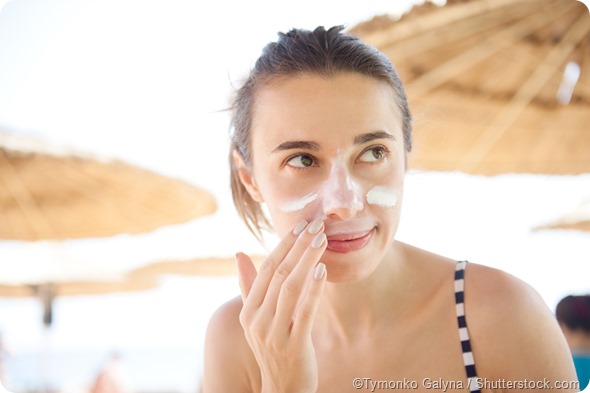When choosing a sunscreen, you must first consider what you will be doing when wearing it, for example if you're running, the sunscreen you choose must be able to withstand sweating.
You also have to consider your environment, for example does my sunscreen need to be waterproof? Generally, it's easier to have one go-to product that you like, you tolerate, and is easily accessible. If you find a product you are happy with, stick with it.

There are also certain key features that you need, such as an appropriate SPF factor. For both the Northern and Southern Hemisphere, generally the minimum I recommend is 50 SPF, this is because most people do not apply enough sunscreen.
The majority of people put on about half the amount that you actually need in order to get the full effects of the SPF factor shown on the product. This is the problem with using a sunscreen that only has a 25 or 30 SPF.
There’s a guidance of 7 teaspoons of sunscreen to cover your entire body, which is approximately 35 ml. The average bottle size is between 150 to 200 ml so that's about a week's worth.
Many of us have a bottle of sunscreen from the previous summer sitting at home still unfinished, simply because we haven't used enough.
What does SPF actually mean? How do you know which factor is necessary?
SPF is a ratio, effectively, if you're going out in the sun and it takes you 5 minutes for your skin to start to burn, if you have a sunscreen on that takes say 50 minutes before you start to burn, you then take a ratio and it's 1 to 10, so it's SPF 10.
If you burn within 30 seconds, and some people do, using an SPF of 50 will give you some protection but once that time's over you're back at risk of burning again.
Even though you are reapplying sunscreen, your skin will still be accumulating sun damage. For example, if your skin is at its threshold of 80% before it’s about to burn, simply putting on more sunscreen isn't going to reset you back to zero again.
This is often a misconception about reapplying sunscreen, an easy way to think of it is that you are delaying the amount of sun damage going through. Reapplying sunscreen is still important because you're going to be giving your skin some protection even though it’s perhaps not as much as you think.
The most sensible thing is to appreciate that SPF isn't a magic shield and that practising good behaviour is the best form of protection for your skin, such as: seeking shade between 11:00 AM and 3:00 PM and wearing appropriate clothing, like a good well-woven cotton t-shirt, which is a fantastic SPF and it's almost total block. Although many skin products claim to block the sun’s damage, not all of them do.
To find out what SPF a piece of clothing has, you must look at its weave. Well-woven products and some synthetic products, like some of the rash vests for example, can give great sun protection. This is better than putting on a sunscreen and less risky because you know you are covering your body properly, for example when applying sunscreen there are some hard to reach areas of the body, such as: the small of your back.

When should you apply sunscreen? Do you need to apply it a set length of time before going out in the sun?
Often sunscreens have a barrier in them, such as a titanium dioxide reflective barrier, as well as chemical constituents. Therefore, as soon as you have rubbed it in and you can no longer see it, it is ready.
You can be more considered about it and apply it before going out in the sun and then reapply if necessary, but when looking at practical, real world, situations, we're putting sunscreen on at the beach when we get there – that’s better than not putting any on.
Should you apply it under or over moisturisers, makeup, deodorants etc.?
Ideally it should be the last thing you put on, this is because of the titanium dioxide, which acts as a reflector, should be the top layer and you don't want to wipe it off with another product.
However, some commercial products have chemicals that offer some protection factors as well as acting as physical barriers. In these scenarios, putting sunscreen on before make-up products etc. is fine.
The order of applying sunscreen doesn't make that much of a difference, providing you don’t wipe off the titanium layer.
Often people complain about a slightly powdery or pale look to their faces this is caused by the tiny microscopic titanium dioxide granules. It is however still important to apply sunscreen, even when wearing other products, because even if you do wipe off the reflective titanium layer there is still the chemical component that will protect you.
How often do you need to reapply sunscreen?
I would advise that you should be thinking about reapplying it at least every couple of hours, it is especially important to reapply if you have just been swimming.
What’s the best way of staying safe in the sun when swimming?
There are swimming vests that are available and are great for protecting your back and your arms, I would recommend these especially for children because they often play in and out of the sea, they won't be able to reapply their sunscreen all the time.
Clothing that offers a barrier is very effective and well tolerated and in addition to this, they can provide protection against bites and jellyfish too.

How important is it to wear a hat and sunglasses?
It’s very important, they give you good protection and shade on your face. The hat is especially important for those with thinner hair, which is common amongst older men.
Girls can also get burnt on their scalp where their parting is and this can lead to skin cancer later on. There aren’t many products available that you can put on your scalp and putting general sunscreen on would make your hair oily and so a hat is ideal.
Wearing sunglasses is important too because chronic ultraviolet exposure to your eyes contributes to macular degeneration, and they provide a good protection against that. Intraocular melanomas can occur and although the causes are a little bit less predictable, it can't hurt to have protection from ultraviolet on your eyes. They also make it more comfortable to see in the sunlight and reduce the development of crow’s feet around the eyes.
How often should you check your skin?
First of all, it’s important not to become too paranoid about this and not to medicalize your life. Doing a check once a month is about right, I would recommend combining it with other health checks that you do. For example, if you're a woman, checking your breasts or if you're a man, checking your testicles.
Also ask yourself questions about bowel habit changes etc. A general check-up should only take about 5 minutes. You can pick up a lot of signs of malignancy just by having a timeout for 5 minutes, once a month.
In order to check your skin, you need access to a good mirror so that you can look at your back, you can always use a shop changing room mirror if you do not have one available at home.
There are also places you can go to get digital photography done. You should always make sure that it is carried out by a qualified person who can act on what they're seeing, and is not just a technician.
What sort of changes should you look out for when checking your moles and skin?
Spots that last longer than three weeks are a cause for concern, especially for those over 30. This isn’t normal and could represent a non-melanoma skin cancer. Things to look out for is anything that is: changing, new, painful or sore or any dark marks appearing.
Only 1 in about 3 melanomas comes from a pre-existing mole, the other 2 out of 3 just come de novo, from a melanocyte that's gone malignant.
We're covered in melanocytes all over our body, otherwise we'd have white patches everywhere. You have to be mindful if a mole changes, whether it's lighter or darker.
For a guide on what changes to look out for, it’s good to be aware of the ABCD rules:
- Asymmetry: if your mole's suddenly got a funny shape that's not symmetrical.
- Border irregularity: borders become blurry or fuzzy or scalloped.
- Color: change in color, lighter or darker.
- Diameter: Increasing in size to greater than the end of a pencil, so approximately 6mm, is not normal.
However, there are times in your life when a change in the appearance of a mole is normal, for example in your teenage years during puberty, flat moles can suddenly become more bubbly.
When you get into your 30's and 40's your moles generally lose their color and become a little bit thicker, the structures mature, hairs beginning to protrude out from them.
What should you do if you spot any changes to a mole or patch of skin? What can you expect?
If you’re unsure, it’s good to check with a qualified person if a mole change is normal or not, and if it’s abnormal it can be taken out for analysis.
In the situation, where a physician would like to take the mole for analysis, in the UK, the typical process you can expect after visiting your family doctor is as follows: you will receive a fast-track referral and be seen within 2 weeks at a NHS facility by a dermatologist usually, or a surgeon who has close links with the dermatology department or a skin cancer unit.
They will sometimes offer you an excision biopsy on that day, that's what we try to practice, to see and treat on the day. Or they will operate on you within a few weeks of seeing you, to remove the mole, get it sent out for testing, or the patch, and make a plan from there.
It's a very quick process, which is great. It's one of the things that the NHS provides a fantastic service for.
How important is early detection of skin cancer?
Detecting skin cancer early is very important on 2 different levels.
For the non-melanoma skin cancers such as basal cell carcinomas, where the risk of mortality is quite low, the main problem is that they can become very large and even erode down to bone. Delaying diagnosis will cause them to be bigger and this results in larger areas being cut out from you that could have been minimalized. Detecting it early can leave you with a smaller wound, a better cosmetic result and an easier procedure, which will allow you get on with your life quicker.
It is even more vital with melanomas as the longer you leave them, the more aggressive they will get and the higher the chance of them spreading. Early detection saves lives.
Where can readers find more information?
About Dr Bav Shergill
 Dr Bav Shergill, Consultant Dermatologist and British Skin Foundation spokesperson
Dr Bav Shergill, Consultant Dermatologist and British Skin Foundation spokesperson
Bav Shergill obtained his medical qualifications from Guy's and St Thomas' hospitals and trained in Dermatology at many different London teaching hospitals.
After gaining his Dermatology accreditation, he undertook further specialist training in Mohs technique and laser surgery. His specific areas of expertise are skin cancer, skin and laser surgery and cosmetic dermatology.
Bav has represented the British Skin Foundation in a variety of ways over the last 8 years, both professionally and by fundraising. From providing essential information as part of the BSF’s It Takes Seven Skin Cancer appeal, to completing the British 10k in aid of the BSF.
A BSF Trustee since 2013, Bav is always on hand to provide key medical advice that is issued directly to the public or the media, in addition to being regularly available to comment on current skin issues in the press.